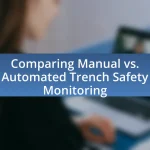The article focuses on enhancing worker safety in trench monitoring, emphasizing the critical role of human factors in preventing accidents and injuries associated with trench work. It outlines the importance of effective monitoring systems that assess soil stability and environmental conditions, as well as the significant impact of human behavior on safety outcomes. Key topics include the necessity of comprehensive training programs, the use of protective systems, and the implementation of real-time monitoring technologies. The article also addresses common hazards, challenges, and best practices for ensuring safety in trench operations, highlighting the need for clear communication and ongoing education to mitigate risks effectively.

What is Enhancing Worker Safety in Trench Monitoring?
Enhancing worker safety in trench monitoring involves implementing strategies and technologies to prevent accidents and injuries associated with trench work. This includes the use of monitoring systems that detect soil stability, gas levels, and other environmental factors that could pose risks to workers. For instance, the Occupational Safety and Health Administration (OSHA) reports that trench collapses can be fatal, emphasizing the need for effective monitoring to ensure worker safety. By utilizing advanced monitoring tools and adhering to safety regulations, organizations can significantly reduce the likelihood of trench-related incidents, thereby protecting workers on-site.
How does the human factor influence trench monitoring safety?
The human factor significantly influences trench monitoring safety by affecting decision-making, situational awareness, and adherence to safety protocols. Human error, such as misjudgment of trench conditions or failure to follow safety guidelines, can lead to accidents and fatalities. For instance, studies indicate that approximately 70% of trench-related incidents are attributed to human factors, including inadequate training and lack of communication among workers. This highlights the necessity for comprehensive training programs and effective communication strategies to enhance safety in trench monitoring.
What roles do workers play in ensuring safety during trench operations?
Workers play a critical role in ensuring safety during trench operations by actively monitoring conditions, adhering to safety protocols, and communicating hazards. Their responsibilities include inspecting trench walls for signs of collapse, using protective systems such as shoring or trench boxes, and ensuring proper access and egress points are maintained. According to the Occupational Safety and Health Administration (OSHA), proper training and awareness among workers significantly reduce the risk of accidents, with statistics showing that trench-related fatalities can be minimized by up to 90% when safety measures are strictly followed.
How can human behavior impact trench monitoring effectiveness?
Human behavior significantly impacts trench monitoring effectiveness by influencing adherence to safety protocols and the accuracy of monitoring practices. When workers are vigilant and follow established safety guidelines, the likelihood of detecting hazards increases, thereby enhancing overall safety. Conversely, complacency or negligence can lead to oversight of critical warning signs, resulting in increased risks of accidents. Research indicates that human error accounts for approximately 70% of workplace incidents, underscoring the importance of behavioral factors in safety outcomes. Therefore, fostering a culture of safety awareness and accountability among workers is essential for improving trench monitoring effectiveness.
Why is trench monitoring critical for worker safety?
Trench monitoring is critical for worker safety because it helps prevent cave-ins, which are a leading cause of fatalities in excavation work. According to the Occupational Safety and Health Administration (OSHA), approximately 25% of excavation-related fatalities are due to collapses, emphasizing the need for effective monitoring systems. By continuously assessing soil conditions, water levels, and structural integrity, trench monitoring ensures that workers are alerted to potential hazards, thereby significantly reducing the risk of accidents and injuries on the job site.
What are the common hazards associated with trench work?
Common hazards associated with trench work include cave-ins, falls, hazardous atmospheres, and equipment-related incidents. Cave-ins are the most significant risk, as they can occur suddenly and lead to serious injuries or fatalities; according to the Occupational Safety and Health Administration (OSHA), approximately 75% of trench-related fatalities result from cave-ins. Falls into trenches can also pose a danger, particularly if proper barriers or protective measures are not in place. Additionally, trenches may contain hazardous atmospheres, such as toxic gases or low oxygen levels, which can endanger workers’ health. Equipment-related incidents, including being struck by machinery or tools, further contribute to the risks associated with trench work.
How does effective monitoring reduce risks in trench environments?
Effective monitoring reduces risks in trench environments by enabling real-time assessment of conditions that could lead to hazards such as collapses or exposure to harmful gases. Continuous observation allows for the early detection of soil movement, water accumulation, or changes in atmospheric conditions, which are critical indicators of potential danger. For instance, according to the Occupational Safety and Health Administration (OSHA), proper monitoring can significantly decrease the likelihood of trench-related accidents, which accounted for approximately 23 fatalities in the United States in 2019 alone. By implementing effective monitoring systems, such as sensors and regular inspections, workers can be alerted to unsafe conditions promptly, thereby enhancing overall safety and reducing the risk of injury or fatality in trench environments.

What strategies can enhance worker safety in trench monitoring?
Implementing comprehensive training programs enhances worker safety in trench monitoring. These programs should focus on hazard recognition, proper use of protective equipment, and emergency response procedures. According to the Occupational Safety and Health Administration (OSHA), trenching and excavation work is among the most hazardous construction activities, with cave-ins being a leading cause of fatalities. Regular safety audits and the use of trench boxes or shoring systems further mitigate risks by providing structural support and preventing collapses. Additionally, continuous monitoring of environmental conditions, such as soil stability and weather changes, is crucial for maintaining a safe work environment.
How can training improve worker safety in trench monitoring?
Training can significantly improve worker safety in trench monitoring by equipping workers with essential knowledge and skills to recognize hazards and implement safety protocols. Effective training programs teach workers about the risks associated with trench work, such as cave-ins, and the importance of using protective systems like trench boxes. According to the Occupational Safety and Health Administration (OSHA), proper training can reduce trench-related accidents by up to 50%, highlighting the critical role of education in enhancing safety measures. Furthermore, ongoing training ensures that workers stay updated on the latest safety regulations and best practices, fostering a culture of safety awareness and proactive risk management in trench operations.
What key topics should be included in trench safety training programs?
Key topics that should be included in trench safety training programs are hazard recognition, protective systems, soil classification, and emergency response procedures. Hazard recognition involves identifying potential risks such as cave-ins, falling loads, and hazardous atmospheres. Protective systems, including trench boxes and shoring, are essential for preventing collapses. Soil classification teaches workers how to assess soil types and their stability, which is critical for safe excavation practices. Emergency response procedures prepare workers to act swiftly and effectively in case of an incident, ensuring safety and minimizing injury. These topics are vital for compliance with OSHA regulations, which mandate specific training to reduce trench-related accidents and fatalities.
How often should training be conducted to maintain safety standards?
Training should be conducted at least annually to maintain safety standards. Regular training ensures that workers are updated on the latest safety protocols and practices, which is crucial in high-risk environments like trench monitoring. According to the Occupational Safety and Health Administration (OSHA), annual training helps reinforce knowledge and skills, reducing the likelihood of accidents and injuries. Additionally, refresher courses should be provided whenever there are changes in regulations or procedures, ensuring compliance and safety in the workplace.
What technologies can support trench monitoring safety?
Technologies that can support trench monitoring safety include ground-penetrating radar (GPR), real-time monitoring systems, and smart sensors. Ground-penetrating radar is effective for detecting subsurface conditions and potential hazards, providing critical data before excavation begins. Real-time monitoring systems utilize sensors to track soil movement and environmental conditions, alerting workers to potential collapses. Smart sensors can measure parameters such as soil moisture and pressure, enabling proactive safety measures. These technologies collectively enhance safety by providing timely information that helps prevent accidents in trench environments.
How do monitoring tools enhance worker awareness of hazards?
Monitoring tools enhance worker awareness of hazards by providing real-time data and alerts about environmental conditions and potential risks. These tools, such as gas detectors and vibration sensors, continuously monitor factors like air quality and ground stability, allowing workers to receive immediate feedback on hazardous situations. For instance, a study by the National Institute for Occupational Safety and Health (NIOSH) found that the use of monitoring devices significantly reduced incidents of exposure to harmful gases in confined spaces, demonstrating their effectiveness in increasing awareness and promoting safety.
What are the benefits of using real-time monitoring systems?
Real-time monitoring systems enhance worker safety by providing immediate data on environmental conditions and potential hazards. These systems enable timely alerts for unsafe situations, allowing workers to take preventive actions before accidents occur. For instance, in trench monitoring, real-time data can indicate soil stability, water accumulation, or gas presence, significantly reducing the risk of collapses or exposure to harmful substances. Studies show that organizations implementing real-time monitoring have experienced up to a 30% reduction in workplace incidents, demonstrating the effectiveness of these systems in promoting a safer work environment.

What are the best practices for implementing trench monitoring safety measures?
The best practices for implementing trench monitoring safety measures include regular inspections, the use of protective systems, and continuous monitoring of environmental conditions. Regular inspections should be conducted to identify potential hazards, ensuring that trench walls are stable and free from water accumulation. Protective systems, such as trench boxes or shoring, must be utilized to prevent collapses. Continuous monitoring involves using sensors to detect soil movement or changes in moisture levels, which can indicate instability. According to the Occupational Safety and Health Administration (OSHA), proper implementation of these practices significantly reduces the risk of trench-related accidents, which are among the most dangerous construction hazards, with a fatality rate of approximately 112 deaths per year in the United States.
How can communication improve safety in trench monitoring?
Effective communication can significantly improve safety in trench monitoring by ensuring that all workers are aware of potential hazards and safety protocols. Clear communication channels facilitate the timely sharing of information regarding trench conditions, equipment status, and emergency procedures. For instance, regular safety briefings and the use of two-way radios can help workers report unsafe conditions immediately, reducing the risk of accidents. Studies show that workplaces with strong communication practices experience 47% fewer safety incidents, highlighting the importance of effective dialogue in maintaining a safe working environment.
What methods can be used to ensure effective communication among workers?
Effective communication among workers can be ensured through regular team meetings, clear communication protocols, and the use of collaborative tools. Regular team meetings foster an environment where workers can share updates, discuss challenges, and align on goals, which is essential for maintaining safety standards in trench monitoring. Clear communication protocols, such as standardized reporting formats and designated points of contact, help minimize misunderstandings and ensure that critical safety information is conveyed accurately. Additionally, collaborative tools like project management software and instant messaging platforms facilitate real-time communication, allowing workers to quickly share information and respond to safety concerns. These methods collectively enhance situational awareness and promote a culture of safety among workers in trench monitoring environments.
How does clear communication contribute to a safer work environment?
Clear communication significantly contributes to a safer work environment by ensuring that all workers understand safety protocols and potential hazards. When employees receive clear instructions and feedback, they are more likely to adhere to safety measures, reducing the risk of accidents. For instance, a study published in the Journal of Safety Research found that workplaces with effective communication strategies experienced a 25% decrease in incident rates. This correlation highlights that clarity in communication not only informs workers but also fosters a culture of safety, where employees feel empowered to report unsafe conditions and collaborate on solutions.
What are common challenges in trench monitoring safety?
Common challenges in trench monitoring safety include soil instability, inadequate monitoring technology, and human error. Soil instability can lead to collapses, posing significant risks to workers; according to the Occupational Safety and Health Administration (OSHA), trench collapses account for approximately 75 fatalities annually in the United States. Inadequate monitoring technology may fail to provide real-time data on soil conditions, increasing the likelihood of accidents. Human error, often stemming from insufficient training or awareness, can exacerbate these risks, as workers may misinterpret safety protocols or overlook warning signs. These factors collectively hinder effective trench monitoring and compromise worker safety.
How can organizations address human error in trench monitoring?
Organizations can address human error in trench monitoring by implementing comprehensive training programs and utilizing technology for real-time monitoring. Training programs should focus on safety protocols, hazard recognition, and proper use of monitoring equipment, which can significantly reduce the likelihood of mistakes. For instance, a study by the National Institute for Occupational Safety and Health (NIOSH) found that enhanced training led to a 30% decrease in incidents related to trenching operations. Additionally, integrating technology such as sensors and automated alerts can provide continuous oversight, allowing for immediate responses to potential hazards, thereby minimizing human error.
What strategies can mitigate the impact of environmental factors on safety?
Implementing comprehensive training programs for workers is a key strategy to mitigate the impact of environmental factors on safety. Such training equips workers with the knowledge to recognize and respond to hazardous conditions, such as unstable soil or adverse weather. For instance, studies show that organizations that provide regular safety training experience a 30% reduction in workplace accidents. Additionally, utilizing technology like real-time monitoring systems can enhance safety by providing immediate data on environmental conditions, allowing for timely interventions. Research indicates that companies employing these technologies report improved safety outcomes, with a 25% decrease in incidents related to environmental factors.
What practical tips can enhance worker safety in trench monitoring?
To enhance worker safety in trench monitoring, implement regular inspections and ensure proper shoring techniques are used. Regular inspections help identify potential hazards such as soil instability, while proper shoring techniques, like using trench boxes or hydraulic shores, prevent collapses. According to the Occupational Safety and Health Administration (OSHA), approximately 1 in 5 worker fatalities occur in the construction industry, with trench collapses being a significant risk. Therefore, adhering to safety regulations and utilizing protective systems is crucial for minimizing risks and ensuring worker safety.
How can workers stay vigilant and proactive about safety?
Workers can stay vigilant and proactive about safety by consistently engaging in safety training and maintaining open communication regarding potential hazards. Regular safety training sessions equip workers with the knowledge to identify risks and implement safety protocols effectively. Open communication fosters a culture where workers feel empowered to report unsafe conditions or behaviors without fear of reprisal. According to the Occupational Safety and Health Administration (OSHA), workplaces that prioritize safety training and communication see a significant reduction in accidents and injuries, highlighting the effectiveness of these proactive measures.
What resources are available for ongoing safety education in trench work?
Resources available for ongoing safety education in trench work include the Occupational Safety and Health Administration (OSHA) training programs, which provide comprehensive guidelines and training materials specific to trench safety. Additionally, the National Utility Contractors Association (NUCA) offers safety training courses and certifications focused on trenching and excavation. The American National Standards Institute (ANSI) also publishes standards that serve as educational resources for safe trench practices. These organizations ensure that workers receive up-to-date information and training to mitigate risks associated with trench work, thereby enhancing overall safety in the field.


